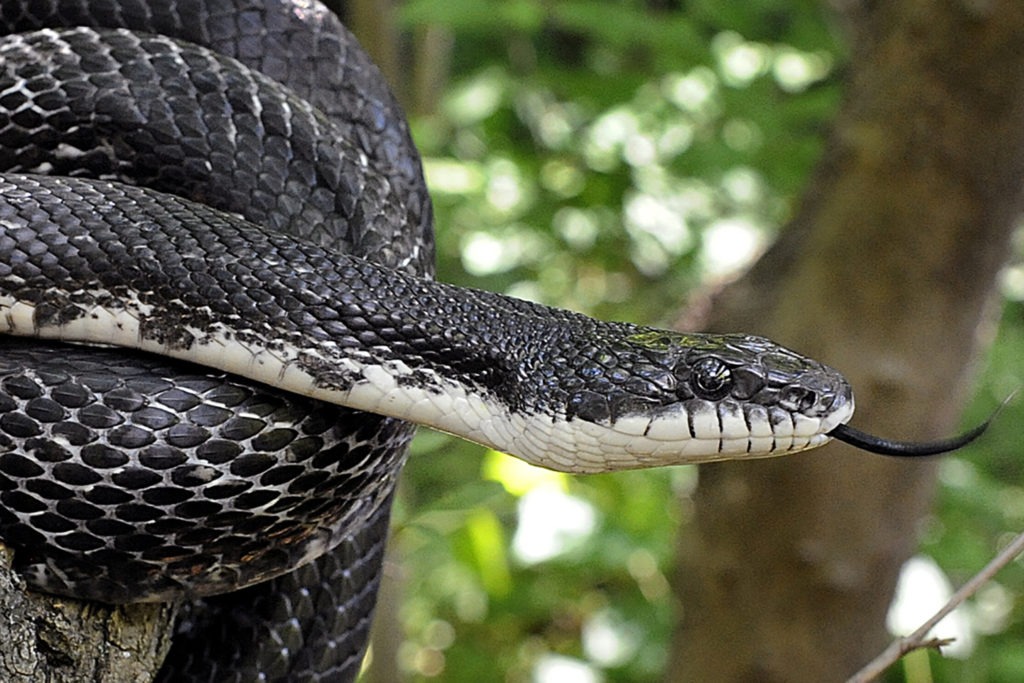Overview
“Where I live”
Black rat snakes are native to the central and eastern United States. They live in a variety of habitats, from rocky hillsides to flat farmland, and are able to survive at wide-ranging elevations.
At the Maryland Zoo in Baltimore, black rat snakes are on exhibit in the Tree in Maryland Wilderness.
“How I live there”
Black rat snakes brumate during the colder months of the year, which is very similar to hibernation but involves a different metabolic processes and allows the animal to be mostly asleep but still capable of occasional activity, such as waking up to drink water, and are active during the warmer months. In the spring and fall they are moving around and sunning themselves during the day, while in summer they are more active at night. As the cold weather sets in, black rat snakes tend to gather in large numbers and share winter dens, with members of their own and other species.
Black rat snakes are non-venomous constrictors that feed mainly on rodents but also on frogs, lizards, birds, and eggs. They are excellent tree climbers and spend much of their time in trees. They also tend to seek shelter in rock outcroppings and stone walls, and may be found in the vicinity of barns, abandoned buildings, and trash piles, presumably hunting for rodents. They have been known to climb into the rafters of buildings.
“Making my mark”
Black rat snakes are eager to avoid contact with humans and are not naturally aggressive, but people who encounter them and are not knowledgeable about them tend to be frightened nonetheless because of their large size. This snake is not especially wide but can attain lengths of up to nine feet, making it one of the longest snakes in North America. (Three to five feet is the more typical range for length, however.)
For their size alone, black rat snakes have suffered unfair persecution. Truth is, if one is seen in the vicinity of a trash dump, abandoned building, or barn, people should leave it alone and even welcome it because it will help to control resident rodent populations.
Raising Young
A few weeks after emerging from winter brumation, black rat snakes begin to breed. Males usually wait for females to cross into their territory and locate them through pheromone trails. Males approach females to initiate breeding. About five weeks after mating, females will deposit their eggs in a hidden area — under leaves or in a rotting log or abandoned burrow — and leave. The eggs will hatch after about two months and from that moment on the baby snakes are on their own. The hatchlings are a good size at birth, usually just over a foot long. They exhibit a distinct gray and black pattern but will darken to all black as they mature.
“What eats me”
Black rat snakes are most vulnerable to predators when they are young and on the smaller side. Foxes, raccoons, owls, and hawks commonly eat them. Adult black rat snakes have few known predators other than humans.
When frightened, a black rat snake will freeze. If harassed, it will produce a foul-smelling musk that serves to deter predators. If provoked further, it may coil, shake its tail, and snap at its attacker.
Conservation
The black rat snake is considered stable throughout its range.
Taxonomy
- Kingdom: Animalia
- Phylum: Chordata
- Subphylum: Vertebrata
- Class: Reptila
- Order: Squamata
- Family: Colubridae
- Genera: Pantherophis
- Species: obsoletus


